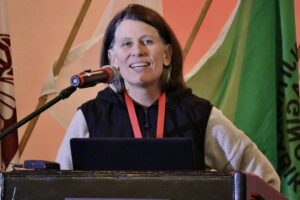New interactive tool to protect Great Lakes Biinaagami showcased at the 2024 Land and Resources Forum

By Kelly Anne Smith
NORTH BAY— All of the Great Lakes have seen declining levels as a result of dry weather, evaporation, and runoff throughout the fall. Lake Superior and Lake Ontario experienced large declining monthly water levels for November.
Now a new interactive multimedia educational tool is being perfected to teach school children about the importance of the Great Lakes and how it is everyone’s responsibility to protect the water.
Biinaagami: Our Shared Responsibility to the Great Lakes was unveiled at the Anishinabek Nation’s 8th Land and Resources Forum, Kina-Gego-Naabadosin – Everything is Connected, in North Bay from February 13-15.
The Anishinabek Nation Commissioner on Governance Patrick Wadaseh Madahbee and Director of Special Projects for Canadian Geographic Meredith Brown presented the concept and process of Biinaagami: Our Shared Responsibility to The Great Lakes. Volunteer-led group, Swim Drink Fish, is also a partner in this project.
Madahbee talked of the beginnings of the Great Lakes Guardian Council when he was Anishinabek Nation Grand Council Chief.
“I was the co-chair of the Great Lakes Guardian Council with Glen Murray, the Minister of the Environment and Climate Change for the province. The initiatives to protect the Great Lakes culminated in a session we had with Josephine Mandamin-baa…talking about the important role of water, water’s living spirit, and of course, the important role that our women play as the water keepers.”
At the time, Madahbee was introduced to Mark Mattson, the founder of Swim Drink Fish, who focuses on keeping water swimable, drinkable, and fishable, as well as The Royal Canadian Geographic Society. Now they all work together on Biinaagami.
Madahbee spoke about Anishinabek Nation Language Commissioner Barbara Nolan of Garden River First Nation and Language Keeper Donna Debassige of Wiikwemkoong First Nation naming the project. Biinaagami in Anishinaabemowin translates to clean, pure water. The women are featured in a Water Ceremony in a Biinaagami video. Madahbee says “our language is so descriptive, it comes with teachings and lessons.”
“The education component is really exciting! We’re going to be going into schools to talk about water, but we are going to be engaging with this concept of shared responsibility of creating engagements and alliances with different people, whether it’s individuals, companies, industry, and different levels of government to really ensure this precious resource—we have over 20 per cent of the world’s fresh water in this area of the Great Lakes and the St. Lawrence Basin—and how important that is to keep this water pure and pristine.”

During their presentation, a huge map of the Great Lakes and the St. Lawrence Basin was laid out in the conference room for participants to explore through augmented reality. Participants were able to take in experiential learning by scanning a QR code with their phones for interactive 3D visuals and inclusive storytelling to appear.
“It’s a chance for us to put down our names— Haudenosaunee, Anishinaabe, and Inuit names— and Indigenous groups that are around the water bodies, the real names of those water bodies. Because a lot of the names of the water bodies are not the real names of those places. But also, as well for people to tell their stories about their water body.”

Meredith Brown says the project aims to help people understand that there are over 200 sovereign First Nations in the watershed.
“That is something that is news to a lot of non-Indigenous people,” she added.
Brown described what will be seen on the enormous Biinaagami map.
“You’ll see all the different Original People’s languages embedded into the map. You’ll see the names of your communities on the map. We’re working on putting placenames on the map…A big part is to really help kind of change the frame of how people think about water to the way all of you think about water as a relation as a living being…What we really hope is that when people are making decisions, whether they are individual decisions, government decisions, they put the health of the Great Lakes watershed in that decision-making.”
As participants gathered on the Biinaagami map to view their community’s waterbodies, Patrick Mahdahbee talked about the warm winter season we are experiencing.
“This one in particular is very warm. It’s probably the first of many, many changes we are going to see with climate change happening. And it’s ironic that so many people don’t think climate change is real. You hear that nonsense south of the border where guy’s like Trump discredit anybody talking about climate change. But open their eyes, it’s happening. Water levels are changing. Temperatures are changing, snow fall levels. Mother Nature is fighting back to a large extent as well. I mean, that’s why there are so many forest fires. You see drought. You see flooding. Every kind of possible scenario is happening because I think again, Mother Earth has a way of balancing things out over time.”
Mahdabee talked about having the Biinaagami: Our Shared Responsibility to The Great Lakes touring schools this coming fall.
“Why it’s really important to get information into the schools is that they’re the future lawyers. They’re the future politicians. They’re the future policy makers and technical people and experts that are going to be the new generation that’s going to make decisions about what’s going to happen. That’s why it’s so important to talk to them.”


